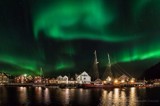The Northern Lights, also known as "Aurora Borealis," one of the greatest natural wonders of our world. This atmospheric phenomenon results from collisions between charged particles released by the sun and the gases, predominantly oxygen and nitrogen, in the Earth's atmosphere. The outcome is a mesmerizing dance of colorful waves of light, especially prominent in Northern Norway. In fact, here is the highest density of aurora borealis in the whole world. At least for now…
Where is Aurora Borealis?
The best places to see the northern lights might change over time. Remember those charged particles from the sun? They enter our atmosphere and concentrate near the poles, forming an auroral oval around them. The auroral oval relates to the magnetic poles and not the geographical poles. Magnetic poles move over time, taking the auroral ovals with them. No worries, we’re talking about centuries, so Northern Norway will still be the hotspot for many years to come.
When can you see it?
To optimize your chances of witnessing the Northern Lights, the recommended time is winter, between October and March. And even though the northern lights are only visible when it’s dark, they can occur at any time of day, in contrary to what some people think. However, our eyes need darkness to be able to perceive them, necessitating a retreat from the lights of urban areas to minimize light pollution.
What makes it colorful?
It’s like magic, the colorfull lightshows, they offer a spectrum beyond the usual green, including purple, blue, pink, and even red. The variety in colors is attributed to the different gases in the Earth’s atmosphere where the two primary gases are oxygen and nitrogen. Green is characteristic of oxygen, while purple, blue or pink colours are caused by nitrogen. Red colours are rare and only occur at higher altitudes when oxygen interacts with solar particles during particularly energetic auroras.
Which planets have it?
Are we the only lucky ones to have this enchanting natural phenomenon on Earth? No, both Jupiter and Saturn, have stronger magnetic fields and auroras have been observed on these gas planets. Other planets in our solar system, like Uranus, Neptune and Mars offer glimpses of this beautiful phenomenon as well. So there is a chance, we’re not the only lucky ones.
Ready to be captivated by the magic of the Northern Lights? Embark on one of our new voyages or join a ski and sail trip to experience this natural wonder firsthand!
Download our Expedition Manual

Receive our expedition manual with a clear overview of our scheduled voyages. Choose your next expedition and step aboard!



